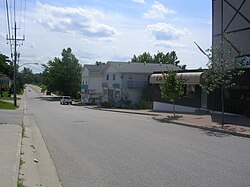Callander, Ontario
| Callander | |
|---|---|
| Municipality (single-tier) | |
| Municipality of Callander | |

Main Street in Callander
|
|
| Motto: Four Seasons of Reasons | |
| Location of Callander in Ontario | |
| Coordinates: 46°13′N 79°22′W / 46.217°N 79.367°W | |
| Country |
|
| Province |
|
| District | Parry Sound |
| Established | 1891 |
| Government | |
| • Type | Township |
| • Mayor | Hector Lavigne |
| • MP | Jay Aspin |
| • MPP | Victor Fedeli |
| Area | |
| • Land | 105.98 km2 (40.92 sq mi) |
| • Metro | 788.48 km2 (304.43 sq mi) |
| Population (2016) | |
| • Municipality (single-tier) | 3,863 |
| • Density | 36.4/km2 (94/sq mi) |
| Time zone | EST (UTC−5) |
| • Summer (DST) | EDT (UTC−4) |
| Area code(s) | 705 |
| Website | Municipality of Callander |
The Municipality of Callander (formerly the Township of North Himsworth) is a township in central Ontario, Canada, located at the southeast end of Lake Nipissing in the Almaguin Highlands region of the District of Parry Sound. The municipality is located on Callander Bay, just south of North Bay.
The municipality renamed itself from North Himsworth to Callander in 2003, adopting the name of its major community because, in the words of then-mayor Bill Brazeau, "Nobody knew where North Himsworth was."
The main community of Callander is located in the northeast corner of the municipality, along the eastern shore of Callander Bay.
The south shore of Callander Bay and Lake Nipissing (southwest of the town) represents the rural population of Callander, which primarily runs along Highway 654 West. This area includes the communities of Wisawasa and Lighthouse Beach.
Callander Bay is an eroded Proterozoic volcanic pipe formed by the violent, supersonic eruption of a deep-origin volcano, approximately 500 million years ago. It is one of eight known volcanic sites in Ontario, including the Manitou Islands in North Bay.
The first people in the Callander area were of Ojibwa and Algonquin descent who have lived around Lake Nipissing for about 9,400 years. Though in history known by many names, they are currently known as Nipissing First Nation. They are generally considered part of the Anishinaabe peoples, a grouping which includes the Odaawaa, Ojibwe and Algonquins.
...
Wikipedia

